Pros
Excellent value; Dual Xeon Scalable Gold 6130 CPUs; 24 PCIe NVMe SSD bays; 384GB of DDR4 included in the price; Great storage performance
Cons
Comparatively basic remote management features; Noisy cooling fans
There's no denying the blue chips like Dell EMC and HPE make the best servers, but you do pay a premium for them and especially so for their all-Flash models. Broadberry Data Systems aims to tempt you with a more budget-friendly alternative; its CyberStore R281-NO0 offers a complete all-Flash solution out of the box at a very competitive price.
Built around Gigabyte's flagship R281-NO0 2U bare-bones rack server, the CyberStore is geared up for a high concentration of PCIe NVMe SSDs and its 24 front bays are ready to receive them with all bridge cards in place and cabled up. Good thermal design allows it to support all Xeon Scalable CPUs up to the 205W TDP 28-core Platinums, and it has room for up to 1.5TB of RDIMM or LR-DIMM memory.
It's a real powerhouse - the price we've shown includes a pair of 2.1GHz 16-core Xeon Gold 6130 CPUs. You won't need to worry about memory for a while either, as Broadberry's generosity stretches to 384GB of 2,666MHz DDR4 RDIMM spread across all 24 DIMM slots.
Broadberry CyberStore R281-NO0: Design and features
The server presents a pleasingly tidy interior with all 12 dual-ported PCIe NMVe interface cables neatly bundled up and tucked out of the way. Gigabyte's uniform backplane design is quite clever: it has three slots at its base that accept any of Gigabyte's expander boards.
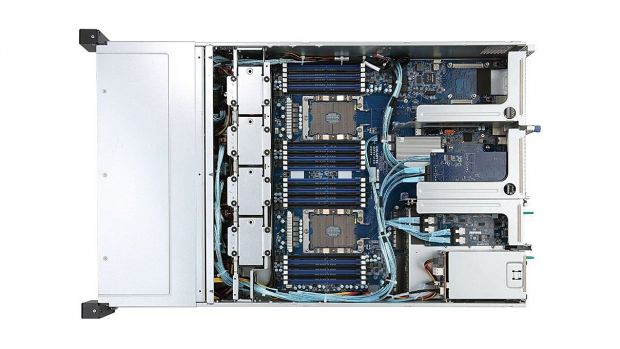
We have all three quad-port PCIe NMVe expanders but you can mix and match them if you want a combination of NVMe and SAS storage. The expander ports are cabled through to three PCIe bridge cards where you have two standard adapters and a third mezzanine card fitted in the motherboard's OCP slot.
The server comes with all three vertical riser cards so even with the resident cards, you still have six spare slots up for grabs. The motherboard also has a second OCP slot available and Gigabyte offers a dual 10GbE SFP+ mezzanine card and a choice of SAS3 RAID controllers - for 25GbE upgrades, you'll need to use standard adapter cards.
You can keep all your NVMe SSD storage for data as the server has a dual SFF drive cage at the rear cabled through to the motherboard's embedded Intel RAID controller which supports mirrors and stripes. The price includes a 256GB Intel SATA SSD and two 1.6TB Intel DC P4600 PCIe NVMe SSDs which cost around £1,100 a pop.
Broadberry CyberStore R281-NO0: VROC and storage performance
Intel's VROC (Virtual RAID on PC) technology allows Intel NVMe SSDs to be configured as bootable RAID arrays without the need for a hardware controller and is enabled by plugging a hardware key into the motherboard. The server includes a VROC Standard key which enables RAID0, 1, 10 and 5 arrays for Intel SSDs. To use other brands such as Samsung, Toshiba or Micron, you'll need a Premium key which costs £175.
It's easy to configure; we enabled Intel's VMD (Volume Management Device) feature in the server's BIOS setup screen and then accessed the VROC directly and created a mirrored RAID array from the two NVMe SSDs. Using the SATA SSD to install Windows Server 2016, we just had to load the VROC drivers and the new NMVe mirror appeared as a standard drive manageable via Intel's RSTe (Rapid Storage Technology enterprise) Windows app.
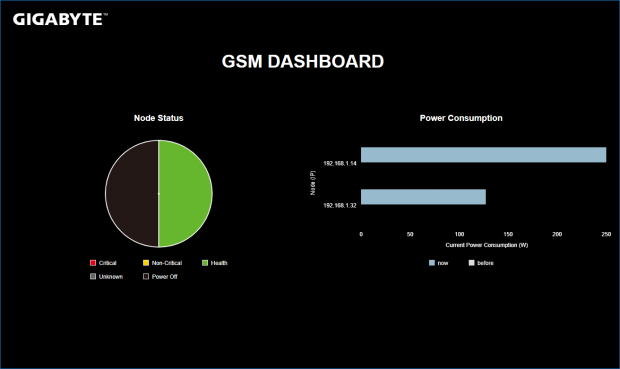
Performance for our NVMe mirror was impressive with the ATTO Disk Benchmark app reporting sequential read and write rates of 5,652MB/sec and 1,372MB/sec. The CrystalDiskMark app generally agreed with these results while Iometer returned random read and write rates of 4,700MB/sec and 1,260MB/sec.
Broadberry CyberStore R281-NO0: Power and management
The server comes as standard with two meaty 1,600W Platinum hot-plug power supplies and we found consumption to be reasonable considering the high specification. With the OS in idle, we recorded a draw of 185W which peaked at 450W with both CPUs under maximum load.
Noise is not so pleasing though, as the four hot-plug fans in front of the motherboard were measured emitting an uncomfortable 73dB at one metre in front of the server. The server offers a range of fan profiles but we were unable to slow them down and reduce sound levels below this.
Gigabyte's remote management features aren't a patch on HPE's iLO5 or Dell's iDRAC9. Nevertheless, the AST2500 web console provides plenty of detail on all critical components, plus it includes full HTML5-based OS remote control and virtual media services come as standard rather than as optional upgrades.
No OS deployment tools are available but Gigabyte does offer its free Server Management utility which can monitor and control multiple systems from one web console. Installed on a Windows Server 2016 host, it automatically discovered the CyberStore's management controller and presented a home page showing a simple pie chart of system availability plus a power consumption bar graph alongside.
Selecting either chart allows you to drill down deeper and view all hardware information, sensor details and an event log. It also provides remote power controls, options to set the boot mode and facilities for mounting virtual media.
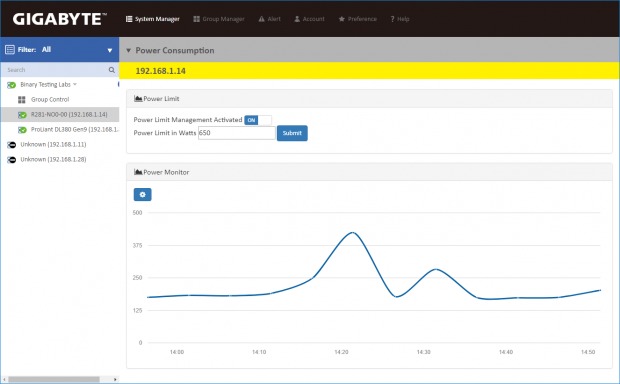
Broadberry CyberStore R281-NO0: Verdict
Broadberry lays the gauntlet down to the blue chips: its CyberStore R281-NO0 offers a mighty all-Flash server solution at a price they can't hope to match. Remote management features are comparatively basic and the cooling fans are a tad noisy, but this 2U rack server teams up a powerful Xeon Scalable package with great expansion potential and complete NVMe-readiness making it a highly cost-effective choice for heavy storage workloads.
SPECIFICATIONS
- Chassis: 2U rack
- CPU: 2 x 2.1GHz Intel Xeon Scalable Gold 6130
- Memory: 384GB 2,666MHz DDR4 RDIMM (max 1.5TB)
- Storage bays: 24 x PCIe NVMe SSD, 2 x SFF SATA (rear)
- RAID support: Intel RSTe SATA RAID 0, 1, 10, Intel NVMe VROC RAID0, 1, 10, 5
- Storage included: 256GB Intel DC S3110 SATA SSD, 2 x 1.6TB Intel DC P4600 PCIe NVMe SSDs
- Network: 2 x Gigabit
- Expansion: 8 x PCIe 3 slots (6 free), 2 x OCP mezzanine slots (1 free)
- Power: 2 x 1600W hot-plug PSUs
- Cooling: 4 x hot-plug fan modules
- Management: Aspeed AST2500 with Gigabit
- Warranty: 3-year on site NBD






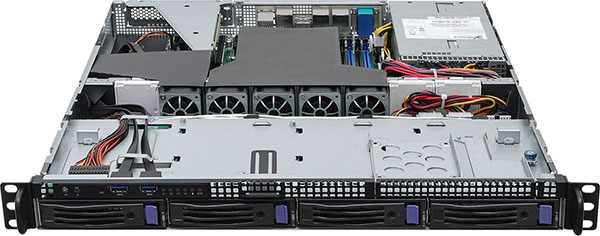
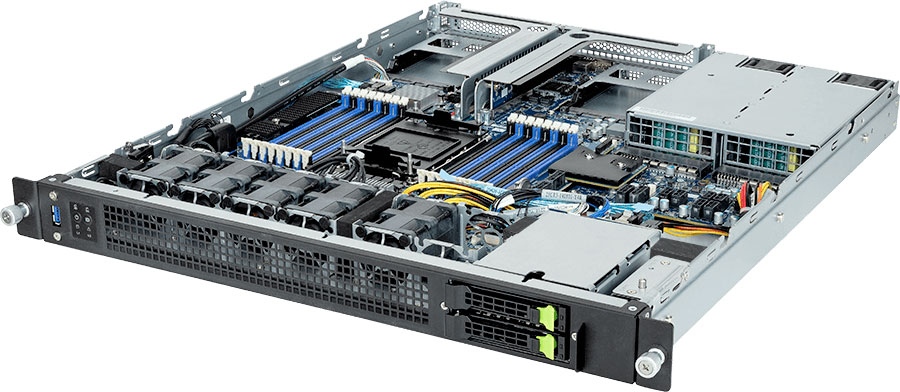


 Call Our South African Sales Team Now
Call Our South African Sales Team Now